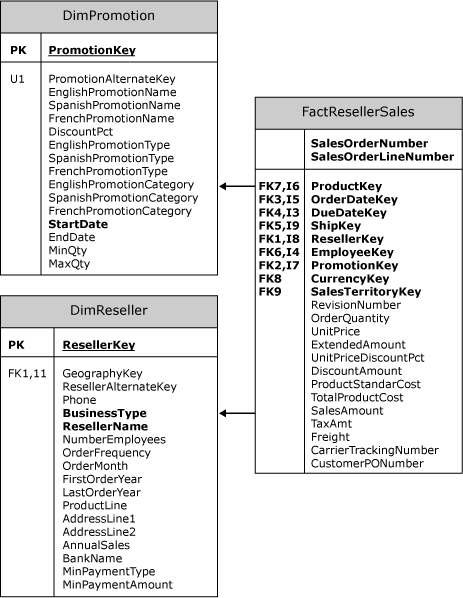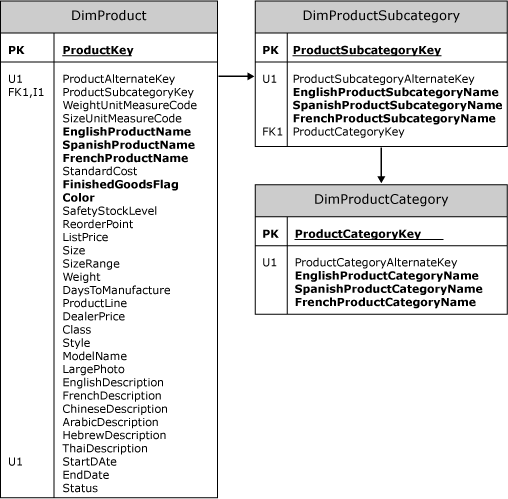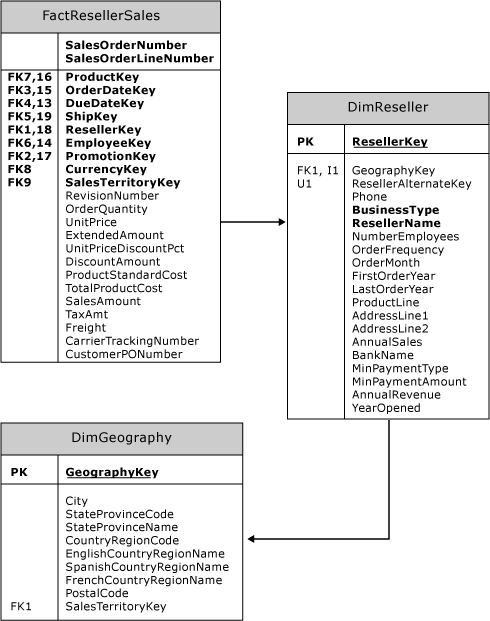Dimensions - Introduction
Applies to:  SQL Server Analysis Services
SQL Server Analysis Services  Azure Analysis Services
Azure Analysis Services  Fabric/Power BI Premium
Fabric/Power BI Premium
All Microsoft SQL Server SQL Server Analysis Services dimensions are groups of attributes based on columns from tables or views in a data source view. Dimensions exist independent of a cube, can be used in multiple cubes, can be used multiple times in a single cube, and can be linked between SQL Server Analysis Services instances. A dimension that exists independent of a cube is called a database dimension and an instance of a database dimension within a cube is called a cube dimension.
Dimension based on a Star Schema Design
The structure of a dimension is largely driven by the structure of the underlying dimension table or tables. The simplest structure is called a star schema, where each dimension is based on a single dimension table that is directly linked to the fact table by a primary key - foreign key relationship.
The following diagram illustrates a subsection of the AdventureWorksDW2012 sample database, in which the FactResellerSales fact table is related to two dimension tables, DimReseller and DimPromotion. The ResellerKey column in the FactResellerSales fact table defines a foreign key relationship to the ResellerKey primary key column in the DimReseller dimension table. Similarly, the PromotionKey column in the FactResellerSales fact table defines a foreign key relationship to the PromotionKey primary key column in the DimPromotion dimension table.

Dimension based on a Snowflake Schema Design
Frequently, a more complex structure is required because information from multiple tables is required to define the dimension. In this structure, called a snowflake schema, each dimension is based on attributes from columns in multiple tables linked to each other and ultimately to the fact table by primary key - foreign key relationships. For example, the following diagram illustrates the tables required to completely describe the Product dimension in the AdventureWorksDW sample project:

To completely describe a product, the product's category and subcategory must be included in the Product dimension. However, that information does not reside directly in the main table for the DimProduct dimension. A foreign key relationship from DimProduct to DimProductSubcategory, which in turn has a foreign key relationship to the DimProductCategory table, makes it possible to include the information for product categories and subcategories in the Product dimension.
Snowflake Schema versus Reference Relationship
Sometimes, you may have a choice between using a snowflake schema to define attributes in a dimension from multiple tables, or defining two separate dimensions and defining a reference dimension relationship between them. The following diagram illustrates such a scenario.

In the previous diagram, the FactResellerSales fact table does not have a foreign key relationship with the DimGeography dimension table. However, the FactResellerSales fact table does have a foreign key relationship with the DimReseller dimension table, which in turn has a foreign key relationship with the DimGeography dimension table. To define a Reseller dimension that contains geography information about each reseller, you would have to retrieve these attributes from the DimGeography and the DimReseller dimension tables. However, in SQL Server Analysis Services, you can achieve the same result by creating two separate dimensions and linking them in a measure group by defining a reference dimension relationship between the two dimensions. For more information about reference dimension relationships, see Dimension Relationships.
One advantage of using reference dimension relationships in this scenario is that you could create a single geography dimension and then create multiple cube dimensions based on the geography dimension, without requiring any additional storage space. For example, you could link one of the geography cube dimensions to a reseller dimension and another of the geography cube dimensions to a customer dimension. Related topics:Dimension Relationships, Define a Referenced Relationship and Referenced Relationship Properties
Processing a Dimension
After you create a dimension, you must process the dimension before you can view the members of the attributes and hierarchies in the dimension. After the structure of a dimension is changed or the information in its underlying tables is updated, you have to process the dimension again before you can view the changes. When you process a dimension after structural changes, you must also process any cubes that include the dimension - or the cube will not be viewable.
Security
All the subordinate objects of a dimension, including hierarchies, levels, and members, are secured using roles in SQL Server Analysis Services. Dimension security can be applied for all the cubes in the database that use the dimension, or for only a specific cube. For more information about dimension security, see Grant permissions on a dimension (Analysis Services).
See Also
Dimension Storage
Dimension Translations
Write-Enabled Dimensions